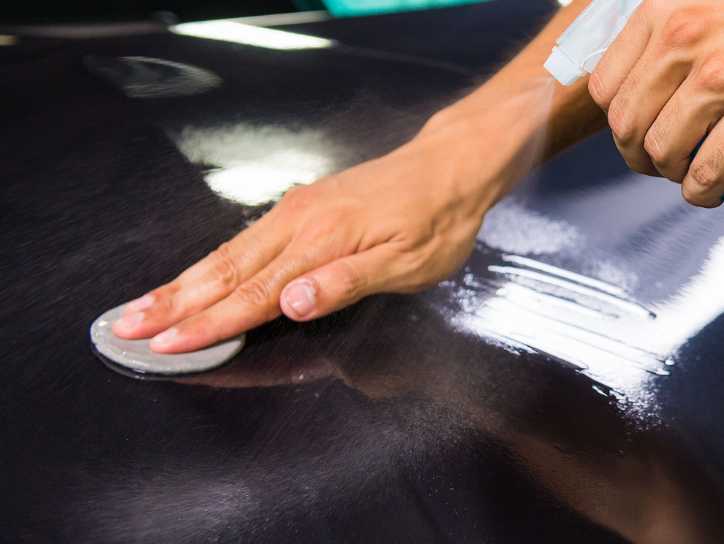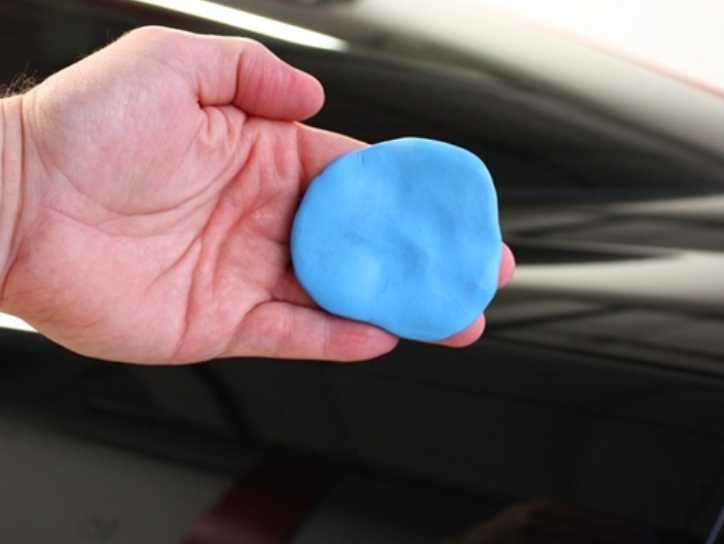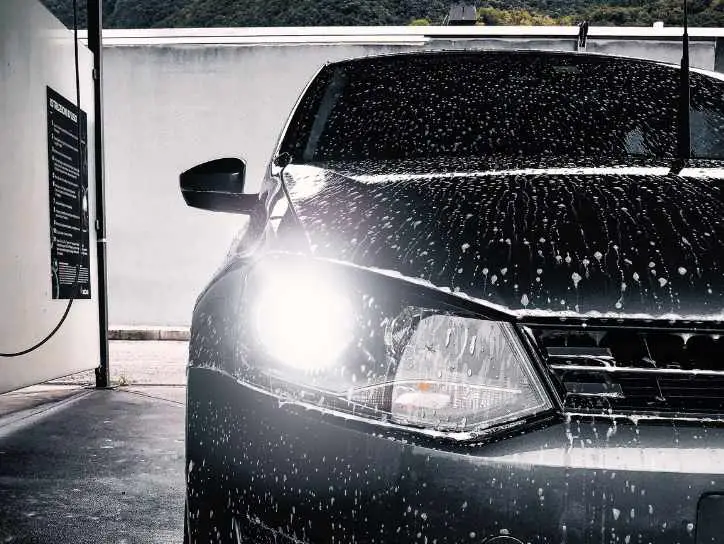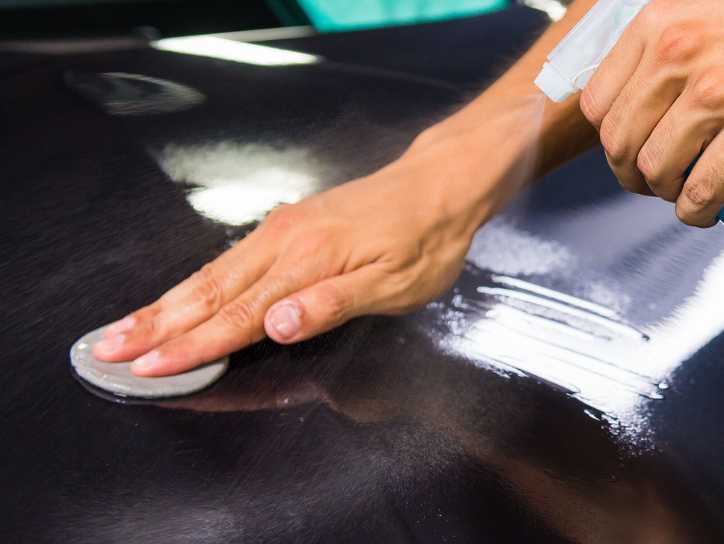Car enthusiasts often encounter stubborn contaminants and imperfections on their vehicle’s surface that regular washing alone cannot address.
Water spots, tar, tree sap, etc. can fade the appearance of a car, leaving owners frustrated with the limitations of traditional cleaning methods.
This is where the clay bar detailing and treatment comes to the rescue.
A revolutionary product in automotive detailing, the automobile cleaning bar offers an effective solution to the challenges of maintaining a pristine vehicle exterior.
In this article, I’ll explain every possible detail around the “clay bar” – definition, its working, price details, application and other details that will help you in better decisions.
What is Clay Bar?

A clay bar is an automobile detailing product used in car care to remove contaminants from the surface of a vehicle’s paint, glass, and metal. It is composed of a malleable synthetic or natural clay-like material, the clay bar is designed to glide smoothly over the car’s surface when lubricated with a detailing spray.
As it moves, the clay bar cleans contaminants such as dirt, brake dust, tree sap, tar, and industrial fallout, leaving the paint surface exceptionally clean and smooth.
This lubrication treatment, known as clay barring, enhances the effectiveness of car cleaning and prepares the surface for polishing and waxing, resulting in a glossy and polished finish.
Benefits of Using a Clay Bar on Vehicles
Clay bar treatments offer several benefits that contribute to your vehicle’s overall health and appearance:
- Smooth Finish: The primary benefit of using a clay bar is achieving an incredibly smooth surface. It removes contaminants that regular washing can’t, leaving the paint silky to the touch.
- Enhanced Shine: With contaminants gone, light reflects more evenly off the paint, resulting in a deeper and more vibrant shine. Your car will look like it just rolled off the showroom floor.
- Improved Paint Health: Contaminants such as road tar, industrial fallout, and brake dust can be corrosive over time. Clay barring helps preserve the integrity of your car’s paint by removing these harmful particles.
- Better Wax and Sealant Adhesion: When your car’s paint is free of contaminants, wax and sealants adhere more effectively. This not only enhances the protective layer but also prolongs the life of these applications.
- Prevents Oxidation: Oxidation occurs when the paint is exposed to the elements over time. By regularly using a clay bar, you remove contaminants that contribute to oxidation, helping to keep your paint looking fresh and vibrant.
- Easier Subsequent Detailing: If you plan to polish, wax, or apply a ceramic coating, using a clay bar beforehand makes these processes more efficient. The smoother surface allows these products to bond better and provides more effective results.
- Preserves Resale Value: Regularly clay barring your car not only keeps it looking great but also helps maintain its resale value. A well-maintained exterior suggests a well-cared-for vehicle.
- Prevents Surface Damage: Contaminants, if left unaddressed, can lead to scratches and swirl marks. Using a clay bar helps prevent these issues, keeping your paint looking pristine.
- Cost-Effective Maintenance: Compared to some other detailing procedures, clay barring is relatively simple and cost-effective. It can be done at home, saving you money on professional detailing services.
- Sensory Enjoyment: The smoothness achieved through clay barring is not just for looks; it’s also a tactile pleasure. Running your hand over a freshly clay-barred car is a satisfying experience.
Uses of a Clay Bar

A clay bar can benefit a variety of surfaces by effectively removing contaminants and restoring a smoother finish. Below are the primary applications that can benefit from applying a clay bar use:
- Car Paint: On automotive, it helps remove hidden contaminants such as road tar, tree sap, and dust, leaving the paint surface smooth and ready for polishing or waxing.
- Vehicle Glass: You can also apply clay to glass surfaces, such as windows and windshields, to eliminate stubborn contaminants like water spots, mineral deposits, and bug splatter. This also enhances visibility and clarity for longer runs.
- Chrome and Metal: Similar to glass, a clay bar is used on chrome parts and metal surfaces including trim and exhaust tips. Claying helps restore their shine and prevents corrosion.
- Plastic Parts: With time, you must have seen, plastic parts like doors, dashboards, etc. develop a rough or faded appearance. Claying can rejuvenate these surfaces, providing a cleaner and more polished look.
- Headlights: Cloudy or hazy headlights can be treated with a clay bar to remove surface contaminants and improve light output. This enhances both appearance and safety.
Note: Similar to cars, boats and recreational vehicles with painted surfaces can benefit from claying to remove salt deposits, oxidation, and other contaminants.
How Does a Clay Bar Work on a Vehicle’s Body?
A clay bar works by physically removing contaminants from a car’s paint surface through a process known as claying. It is engineered and designed to be gentle on the vehicle’s paint while effectively lifting and trapping contaminants.

Before use, a lubricant is applied to the paint surface to ensure smooth gliding of the clay bar and to prevent scratching.
During the claying process, a detailer or you (if applying yourself) gently rub the clay bar across small sections of the paint, feeling and seeing it pull contaminants away.
Once done, you will see a smoother paint finish, enhancing the overall appearance of the vehicle. It’s important to follow claying with a thorough rinse to remove any remaining lubricant and loosened contaminants, leaving the car with a refreshed and decontaminated surface.
Regular use of a clay bar, as part of a comprehensive detailing regimen, helps maintain a vehicle’s exterior in top condition, preserving its visual appeal and protecting the paint over the long term.
Price of a Clay Bar
The price of a clay bar starts from $5 and goes up to $50 or even more. However, the price can also vary based on the brand, quality, and quantity included in a package.
Different Types of Clay Bar
There are 3 most common types of clay bars in the market – Fine, Mild, and Medium. Each type is designed for specific applications and varies in characteristics.

Below are 6 different types of clay bars along with their applications, expected price range, and characteristics:
1. Mild Clay Bars
Suitable for regular decontamination and maintenance of lightly contaminated paint surfaces. Ideal for use on well-maintained vehicles.
- Characteristics: Gentle on paint, less abrasive, suitable for frequent use.
- Expected Price Range: $10 to $20
2. Medium Clay Bars
Effective for removing moderate levels of contaminants from automotive paint, including tar, road grime, and industrial fallout.
- Characteristics: More aggressive than mild clay bars, suitable for periodic use.
- Expected Price Range: $15 to $30
3. Aggressive Clay Bars (Heavy Duty)
Designed for tackling heavy contamination on neglected paint surfaces, such as deep-seated industrial fallout, stubborn tar, or overspray.
- Characteristics: More abrasive, best used on surfaces with significant contamination.
- Expected Price Range: $20 to $40
4. Fine (Polishing Clay Bars)
Intended for smoothing out minor imperfections in the paint surface and enhancing gloss. It is often used after using a more aggressive clay bar.
- Characteristics: Finer particles, help in achieving a polished finish.
- Expected Price Range: $15 to $25
5. Synthetic Clay Bars
Made of synthetic materials, suitable for various surfaces including paint, glass, and metal.
- Characteristics: Less prone to crumbling, longer lifespan than traditional clay bars.
- Expected Price Range: $15 to $30
6. Specialized Clay Bars
Some clay bars are designed for specific purposes, such as removing water spots, iron deposits, or tar. They may come with additional features like colour-changing technology.
- Characteristics: Tailored for specific contaminants or tasks.
- Expected Price Range: $20 to $50
Note: The prices mentioned above are for your idea only. Real price can vary based on the brand you prefer and location.
Car Clay Bar Color Codes
Clay bars often come in different colours, and these colours typically indicate the aggressiveness or abrasiveness of the clay. The most common colour codes are:
| Clay Type | Colour |
| Fine | Grey |
| Mild | Blue |
| Medium | Grey |
| Aggressive | Purple |
| Synthetic | Grey |
| Specialized | NA |
Note: These colours can vary based on different brands.
How to Choose the Right Clay Bar?
Choosing the right clay bar involves assessing contamination and paint sensitivity. For light contamination, use a mind clay bar; for moderate, a medium one. Reserve hard clay bars for heavy contamination but be cautious with sensitive paint.
You are requested to stick to reputable brands, read product descriptions, and use proper lubrication. Start with a softer option, test in a small area, and gradually adjust based on your car’s needs for effective and safe detailing.
How Often Should You Clay Bar Your Car?
Claying your car depends on factors like your driving conditions and how well you maintain your vehicle.
In general, consider claying your car twice a year for regular maintenance. However, if you frequently drive in areas with a lot of pollution, tree sap, or construction dust, you are advised to use clay bars more often.
When Should You Use a Clay Bar?

Here’s a simple guide on when and how often to clay bar your car:
- Spring and Fall: Claying your car twice a year, ideally in the spring and fall, is a good routine for many car owners. This helps remove contaminants that accumulate over time.
- After Long Trips or Harsh Conditions: If you take a long road trip or your car is exposed to harsh conditions like heavy rain, road construction, or industrial fallout, it’s a good idea to clay bar your car afterwards.
- Visual Inspection: If you notice your car’s paint feels rough or looks dull, it’s a sign that contaminants have built up, and it’s time to clay.
- Visual Inspection: Regularly inspect your car’s paint. If it feels rough or looks dull, it’s a sign that contaminants have built up, and it may be time for a clay bar treatment.
- Tailor to Your Environment: If you live in an area with a lot of tree sap, bird droppings, or industrial pollutants, you might need to clay your car more frequently.
Steps to Use Clay Bar on Your Car
Using clay is a simple process that involves a few key steps. Let’s understand each step:

- Wash Your Car: Start with a thorough car wash to remove loose dirt and grime.
- Prepare the Clay: Put the clay bar into a flat, palm-sized shape. Use a clay lubricant or a mixture of water and car wash soap as a lubricant.
- Lubricate the Surface: Spray the lubricant on a small section of your car’s surface (1ft x 1ft). Ensure it stays wet throughout the claying process.
- Clay the Surface: Start claying gently over the lubricated area using back-and-forth, side-to-side and up-to-down motions. The clay will pick up contaminants. Fold and reshape the clay frequently to expose a clean surface.

- Feel for Smoothness: Once the surface feels smooth, move on to the next section.

- Wipe-Off Residue: After claying a portion, wipe off any residue with a clean microfiber cloth.
- Apply Wax or Sealant: To protect the freshly cleaned surface, consider applying a layer of wax or sealant.
Signs that Your Car Needs a Clay Bar Treatment
Here are some signs that indicate your car may need a clay bar treatment:
- Rough Paint Texture: Run your hand over the car’s paint. If it feels rough or bumpy instead of smooth, it’s a sign that contaminants have bonded to the surface.
- Dull Appearance: If your car’s paint looks dull and lacks the usual shine, it could be due to a build-up of pollutants and contaminants.
- Visible Contaminants: Look closely at the paint surface. If you see spots of tar, tree sap, road grime, or other stubborn contaminants that regular washing doesn’t remove, it’s time for a clay bar treatment.
- Difficulty Washing or Water Beading Issues: If water doesn’t bead on the paint as it used to, or if washing your car doesn’t restore its cleanliness, contaminants may be interfering with the protective layer.
- After Long Drives or Harsh Conditions: If you’ve been on a long road trip or your car has been exposed to harsh conditions such as heavy rain, construction zones, or industrial fallout, it’s likely accumulated contaminants that need removal.
- Frequent Exposure to Pollutants: If you regularly park your car near factories, construction sites, or areas with high pollution levels, your car is more prone to contamination and may benefit from more frequent clay bar treatments.
- Tree Sap or Bird Droppings: Stubborn substances like tree sap or bird droppings can adhere to your car’s paint and may not come off with regular washing. These are clear indicators that a clay bar treatment is needed.
Common Mistakes to Avoid During a Clay Bar
Please take care of the given observation while claying your vehicle:
- Always wash your car before using a clay bar to remove loose dirt and grime.
- Please ensure the surface is well-lubricated to prevent the clay bar from marring the paint.
- You are requested to inspect and knead the clay bar to expose a clean surface, especially if it becomes heavily soiled.
- Use gentle pressure to avoid inducing scratches or swirl marks on the paint.
- Apply the clay bar under a shaded area to prevent the lubricant from drying too quickly and hindering the clay bar’s effectiveness.
- Before treating the entire car, test the clay bar in a small, inconspicuous spot to ensure compatibility and assess the results.
- Apply a protective wax or sealant to maintain the cleaned surface and protect the paint.
- If your car has delicate paint, avoid using a hard clay bar to prevent potential damage.
Note: Take your time during the claying process to ensure thorough cleaning without causing harm to the paint.
Clay Bar Before and After: What’s Impact?

Before and after clay bar treatment, the difference in a car’s paint finish can be quite noticeable.
Before using a clay bar, the paint surface often feels rough to the touch due to contaminants such as road grime, tar, and other pollutants.
These contaminants can diminish the smoothness and appearance of the paint. However, after a clay bar treatment, the surface becomes significantly smoother. The clay bar effectively removes these contaminants, leaving the paint feeling sleek and enhancing its overall appearance.
Note: The transformation is not always dramatic in terms of colour or shine, but the tactile difference in smoothness is a key indicator of the success of the clay bar process.Top of Form
Alternatives of Clay Bar
In addition to traditional clay bars, there are alternative products and methods for decontaminating a car’s paint surface. Below are some popular alternatives including:
- Clay Mitts or Pads: These alternatives are made of synthetic materials and function similarly to traditional clay bars. Synthetic clay mitts are worn on the hand, offering ease of use, while clay pads can be attached to a machine polisher for mechanical decontamination.
- Clay Towels or clay mitts: These tools combine the decontamination properties of clay with the convenience of a microfiber towel. They are user-friendly and can cover larger areas quickly.
- Detailing Clay Sprays: Some manufacturers offer detailing clay in a spray form. These products are sprayed onto the paint surface, and contaminants are then lifted with a microfiber cloth. This method can be quicker than traditional clay bars.
- Clay Pads: Similar to synthetic clay pads, these can be attached to a dual-action polisher for mechanical decontamination. They offer a larger surface area and can be more efficient for larger vehicles.
How Many Times I Can Use a Clay Bar?
You are requested to use a clay bar up to 20 times for best results and without harming the vehicle’s surfaces.
What is Surface Contamination?
Surface contamination on vehicles refers to the presence of tiny, unwanted particles that stick to the car’s paint, such as road grime, tar, tree sap, industrial fallout, and other pollutants. These contaminants can make your car’s surface feel rough and look dull.
What is Car Bar Mitt?

A clay bar mitt is a tool used in the clay bar process for detailing a car’s paint surface. It is an alternative to the traditional clay bar, which is a small, malleable piece of clay-like material. The mitt is worn on the hand, making it easier to glide over the surface of the vehicle. It helps remove contaminants such as dirt, road grime, brake dust, and other pollutants from the paint surface.
What is a Car Bar Detailing Kit?
A clay bar detailing kit typically includes various items necessary for the clay bar process. These kits commonly contain a clay bar or clay bar mitt, a lubricant, and sometimes other accessories like microfiber towels. The clay bar is used to physically pull contaminants from the surface, and the lubricant helps the clay glide smoothly over the paint, reducing the risk of scratching. Some kits may also include additional products for further detailing, depending on the brand and type of kit.
What is Clay Bar Lubricant?

Clay bar lubricant is a liquid used in car detailing with a clay bar to reduce friction and prevent scratches on the paint surface. It suspends and encapsulates contaminants, allowing the clay to lift and remove impurities, leaving a smooth surface. Always follow the manufacturer’s instructions for best results.
How Long Does It Take to Clay Bar a Car?
The time to clay bar a car can vary from 1 to 3 hours depending on the size of the car, the level of dirt on the paint, and the detailer’s skill. Rushing the process can damage the paint, so it’s essential not to hurry. The duration may be longer if additional detailing steps like polishing or waxing are included.
How Long Does a Clay Bar Last on a Car?
A clay bar treatment on a car’s paint surface can last from a few weeks to a few months. Factors such as environmental conditions, driving habits, and maintenance practices affect its longevity. Regular washing, proper maintenance, and the use of protective products like wax or sealant can help extend its effectiveness. Reapply the clay bar when the surface feels rough or accumulates contaminants for continued paint protection. Top of Form
FAQs
Can you clay bar vinyl wrap?
Yes, you can clay bar a vinyl wrap, but exercise caution. Use a mild clay bar and a lubricant to prevent scratches. Apply gentle pressure, and if the vinyl is textured, be mindful not to catch the clay in the texture.
Does the clay bar remove scratches?
Clay bars primarily remove embedded contaminants. They won’t fix scratches. For scratches, use a dedicated scratch remover or consider a more abrasive polishing compound if the scratches are shallow.
Will the clay bar remove bird poop?
Yes, clay bars are effective against bird droppings. Swift removal is crucial, as the acidity in bird droppings can damage the paint. Gently glide the clay bar over the affected area.
What types of contaminants can car clay remove from a car’s surface?
Car clay is effective in removing various contaminants such as road tar, industrial fallout, tree sap, bug residue, and other stubborn particles that can adhere to the car’s paint.
Will the clay bar remove rail dust?
Yes, clay bars work well for removing rail dust. The clay’s sticky texture helps lift these tiny, often rusty, particles embedded in the paint.
Will the clay bar remove sap?
Yes, clay bars are effective against tree sap. Work patiently and use a lubricant to help break down and lift the sap off the paint.
Do you have to wax again after a synthetic clay bar?
Yes, it’s essential to wax or seal the paint after using a clay bar, including synthetic clay. This ensures protection and restores the hydrophobic properties of the paint.
How can you clay bar a car in automatic car washes?
It’s not recommended to use a clay bar in automatic car washes. The process requires precision and control, which is hard to achieve in an automated setting. Handwashing is preferable for clay bar application.
How many companies make clay bars for car paint?
Numerous companies manufacture clay bars, offering a range of options. Popular brands include Meguiar’s, Mothers, Chemical Guys, Griot’s Garage, Clay Magic, and Nanoskin.
Can car clay be used on all types of paint finishes?
Yes, car clay is generally safe for use on all types of automotive paint finishes, including clear coats. However, it’s essential to follow the manufacturer’s instructions and ensure the surface is well-lubricated during the clay bar process to prevent scratching.
Can car clay be used on a newly painted or freshly waxed car?
It is generally recommended to wait for a newly painted or freshly waxed car to cure completely before using car clay. Refer to the product instructions and follow any recommendations regarding the timing of clay bar usage after painting or waxing.
Can I use soapy water with a clay bar?
While water with car wash soap is an acceptable clay lubricant, dedicated clay lubricants offer better performance, reducing the risk of marring the paint.
Can you clay bar a car in the sun?
It’s not ideal to clay bar in direct sunlight as the heat can make the clay too soft, reducing its effectiveness. Work in a shaded area or during cooler times of the day.
How to remove clay bar residue?
Wipe away clay bar residue using a clean microfiber towel or a residue remover. Inspect the surface under different lighting to ensure all residue is removed.
Does a clay bar remove water spots?
Clay bars can remove mild water spots by lifting contaminants. For stubborn water spots, consider a dedicated water spot remover or light polishing.
Conclusion
Clay bar is a practical and game-changer product in automobile cleaning.
With the above guide, you’re well-equipped to elevate your car care routine.
Experience the true potential of your vehicle’s surfaces with a polished finish that satisfies you.
Please drop your questions or suggestions in the comment section below.

